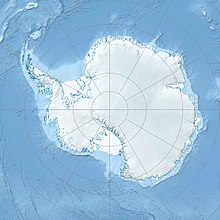Plateau station
Coordinates: 79 ° 15 ′ 3 ″ S , 40 ° 33 ′ 38 ″ E
The plateau station is a no longer operated US research and supply station on the polar plateau in central East Antarctica . It was built as part of the "South Pole – Queen Maud Land Traverse (SPQML)" research expedition from December 13, 1965. In early 1966, a team from the expedition called SPQML II reached the station. It was operated continuously until January 29, 1969, before it was shut down for possible further use. The station was the smallest, coldest, highest, and most remote station maintained by the United States in Antarctica during its service life .
The operator and user of the station was the National Science Foundation in collaboration with the United States Navy . A team of four scientists and four Navy employees under the command of a Navy medic was always on site. The station was originally intended to be used for two years, but was ultimately operated for three years.
Until the opening of Dome F in 1995, Plateau-Station was the highest station in Antarctica at 3624 m . Due to the polar vortex, the effective height is over 4000 m, which predestined the station for research at great heights.
On December 22nd, 2007 the "Norwegian-US Scientific Traverse of East Antarctica" expedition visited the base and found the buildings largely intact.
In 2017 the "Coldest Firn" expedition of the Alfred Wegener Institute stopped at the plateau station. The base was completely covered with snow, only the meteorological tower was sticking out of the snow. The expedition entered the base through a skylight and found it otherwise unchanged. Sepp Kipfstuhl , one of the expedition participants, expressed the opinion: “In ten or twenty years someone can come again, and it will look very similar. The mast can even be seen for another 500 years. "
building
The base was built from five prefabricated units flown in using a Hercules C-130 with ski undercarriage. Four of these units form the 8 × 25 meter main building, a smaller unit (named after the manufacturer as the Jamesway Hut ) was set up around 300 meters of this as an alternative building. Two 75 kW diesel generators were used to supply the main building with energy, the alternative building had its own generator. A 3500 meter long ski slope was built for air transport. For the meteorological observations there was a 32 meter high instrument tower, which was used, among other things, to observe the inversion layer over the snow.
Research activities
The main task for the scientific investigations was the observation of the sun because of the high altitude, the clear air and the relatively short distance to the target object during the summer . In addition, there were unique opportunities to observe unusual weather phenomena:
- Micrometeorological study: For this study, wind speeds, wind directions and temperatures were measured at different heights of the instrument tower in order to determine a "microtopography of the weather", for which the flat plateau was very well suited.
- Study on lighting and absorption: The natural illuminance was measured with an Eppley illuminometer and compared with a model of the direct and diffuse spectral radiation fluxes.
In addition, medical and physiological studies on staff, atmospheric studies, geomagnetic studies and ice core drilling were undertaken. For the latter, however, the station was a less suitable location. On October 29, 1966, there was an earthquake, caused by swimming snow , which led to the entire station dropping suddenly by one centimeter.
climate
The plateau station is one of the coldest points on earth and has a permafrost climate . The lowest measured temperature was on July 20, 1968 at −86.2 ° C, in June of the same year the temperature was already −86.1 ° C.
The annual mean value is −56.7 ° C. The mean temperature in the winter half (April to October) is −70 ° C, that of the summer half (November to March) is −40 ° C. Even if the record low temperatures of the Vostok station are not reached, the mean value is consistently lower.
|
Monthly Average Temperatures for Plateau Station
Source: missing
|
See also
Web links
- Among the Magi : a polar memoir of the first winter at Plateau Station Antarctica by Martin Sponholz, meteorologist in 1966. The Antarctican Society, 1995 [1]
Individual evidence
- ↑ Ted Scambos: Plateau Station . Norwegian-US Scientific Traverse of East Antarctica. Archived from the original on September 24, 2010. Info: The archive link was automatically inserted and has not yet been checked. Please check the original and archive link according to the instructions and then remove this notice. Retrieved October 1, 2017.
- ^ John Stewart: Antarctica - An Encyclopedia . McFarland & Co., Jefferson and London 2011, ISBN 978-0-7864-3590-6 , p. 1224 (English)
- ↑ PLATEAU STATION, ANTARCTICA-CONCEPT, DESIGN, CONSTRUCTION, AND INITIAL OCCUPANCY . Defense Technical Information Center. November 1967. Retrieved October 2, 2017.
- ^ Website of the "Norwegian-US Scientific Traverse of East Antarctica" expedition , accessed on October 1, 2017
- ^ Description of the "Coldest Firn" expedition , section 2.2, p. 22, accessed October 2, 2017.
- ^ Spiegel Online , accessed October 2, 2017.
- ^ PC Dalrymple and LA Stroschein. A Micrometeorological system: Installation, performance, and problems. Meteorological Studies at Plateau Station, Antarctica, ed. by JA Businger, Washington, 1977, American Geophysical Union, 1-5 (Antarct. Res. Ser., 25).
- ^ Kuhn, Michael: Natural Illumination of the Antarctic Plateau . In: Arch. Met. Geoph. Biocl. B. (1973) 21: 55. doi : 10.1007 / BF02245992




